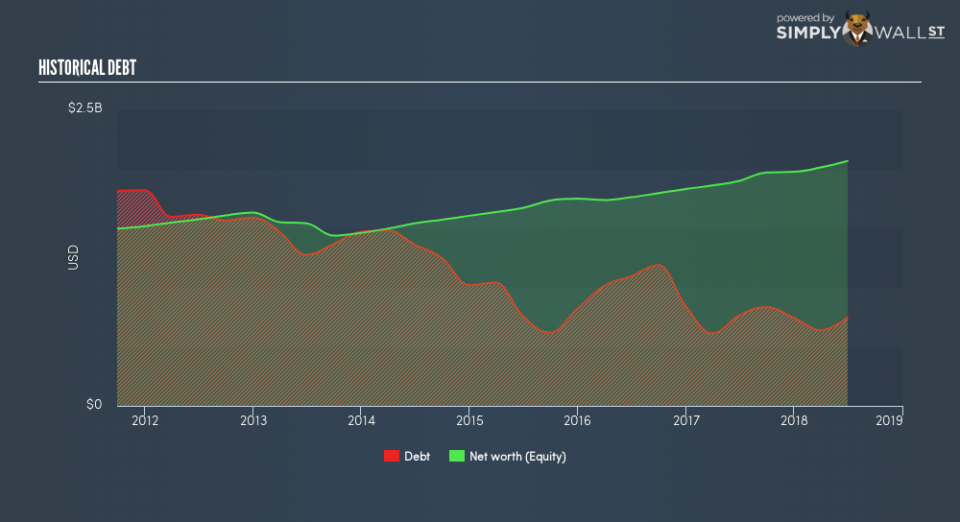Why These Fundamentals Make Cathay General Bancorp’s (NASDAQ:CATY) More Attractive

As a small-cap bank stock with a market capitalisation of US$3.48b, Cathay General Bancorp’s (NASDAQ:CATY) risk and profitability are largely determined by the underlying economic growth of the US regions in which it operates. Since a bank profits from reinvesting its clients’ deposits in the form of loans, negative economic growth may lower deposit levels and demand for loan, adversely impacting its cash flow. After the Financial Crisis in 2008, a set of reforms called Basel III was created with the purpose of strengthening regulation, risk management and supervision in the banking sector. These reforms target banking regulations and intends to enhance financial institutions’ ability to absorb shocks resulting from economic stress which could expose banks like Cathay General Bancorp to vulnerabilities. Unpredictable macro events such as political instability could weaken its financial position which is why it is important to understand how well the bank manages its risk levels. Strong management of leverage and liquidity could place the bank in a protected position at the face of macro headwinds. We can gauge Cathay General Bancorp’s risk-taking behaviour by analysing three metrics for leverage and liquidity which I will take you through now.
Check out our latest analysis for Cathay General Bancorp
Why Does CATY’s Leverage Matter?
Banks with low leverage are better positioned to weather adverse headwinds as they have less debt to pay off. A bank’s leverage may be thought of as the level of assets it owns compared to its own shareholders’ equity. Though banks are required to have a certain level of buffer to meet its capital requirements, Cathay General Bancorp’s leverage level of 7.84x is very safe and substantially below the maximum limit of 20x. This means the bank exhibits very strong leverage management and is well-positioned to repay its debtors in the case of any adverse events since it has an appropriately high level of equity relative to the debt it has taken on to remain in business. If the bank needs to firm up its capital cushion, it has ample headroom to increase its debt level without deteriorating its financial position.
How Should We Measure CATY’s Liquidity?

As abovementioned, loans are quite illiquid so it is important to understand how much of these loans make up Cathay General Bancorp’s total assets. Generally, they should make up less than 70% of total assets, but its current level of 81.6% means the bank has obviously lent out 11.64% above the sensible upper limit. This means its revenue is reliant on these specific assets which means the bank is also more exposed to default compared to banks with less loans.
Does CATY Have Liquidity Mismatch?
A way banks make money is by lending out its deposits as loans. These loans may be fixed term and often cannot be readily realized, yet customer deposits on the liability side must be paid on-demand and in short notice. This mismatch between illiquid loans and liquid deposits poses a risk for the bank if unusual events occur and requires it to immediately repay its depositors. Compared to the appropriate industry loan to deposit level of 90%, Cathay General Bancorp’s ratio of over 101% is higher, which places the bank in a relatively dangerous position given the negative liquidity discrepancy. Essentially, for $1 of deposits with the bank, it lends out more than $1 which is unsustainable.
Next Steps:
We’ve only touched on operational risks for CATY in this article. But as a stock investment, there are other fundamentals you need to understand. I’ve put together three relevant aspects you should look at:
Future Outlook: What are well-informed industry analysts predicting for CATY’s future growth? Take a look at our free research report of analyst consensus for CATY’s outlook.
Valuation: What is CATY worth today? Has the future growth potential already been factored into the price? The intrinsic value infographic in our free research report helps visualize whether CATY is currently mispriced by the market.
Other High-Performing Stocks: Are there other stocks that provide better prospects with proven track records? Explore our free list of these great stocks here.
To help readers see past the short term volatility of the financial market, we aim to bring you a long-term focused research analysis purely driven by fundamental data. Note that our analysis does not factor in the latest price-sensitive company announcements.
The author is an independent contributor and at the time of publication had no position in the stocks mentioned. For errors that warrant correction please contact the editor at editorial-team@simplywallst.com.

 Yahoo Finance
Yahoo Finance 
